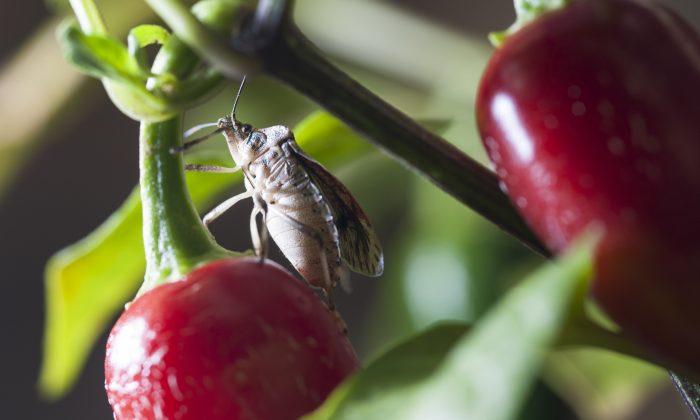Stink bugs in record numbers are expected this year in multiple parts of the United States.
A well-established and quickly growing population of the stink bugs was recently found in Sacramento, to the surprise of researchers. It’s the first reproducing population in California outside Los Angeles County.
“This is one of the worst invasive pests we’ve ever had in California,” said Chuck Ingels, a University of California Cooperative Extension adviser, in the announcement.
“These bugs aggregate in such numbers that there are reports of people using manure shovels and five-gallon buckets to dispose of them,” Ingels said. “The strong, unpleasant odor the insects emit when disturbed makes cleanup still more daunting.”
The quickly rising stink bug population in Dayton, Ohio, has led one local exterminator to deem it the “bug of the year,” reported the Dayton Daily News.
“Some years it’s wasps … Asian Lady Beetles were a problem for a couple years,” said Ken Packard of Bugs or Us Pest Control Inc. “This year it’s stink bugs.”
In Oregon, record numbers of stink bugs could threaten many late-season crops, including blueberries, raspberries, and apples, according to Oregon State University.
Statewide surveys collected by university researchers show that the bug has higher population densities this year in nearly every region in the state, including urban counties.
Even low levels of stinkbugs can result in crop losses, according to Vaughn Walton, an entomologist at the university.
Populations are increasing faster than thought and are peaking around this time.
“Pre-harvest is a time when stink bugs are more likely infest crops and lay eggs because late-stage crops are an attractive food source,” said Nik Wiman, a research entomologist with the university. “The adults and nymphs cause blemishes when they feed on ripening fruit, nuts and vegetables, rendering them unmarketable.”
The brown marmorated stink bug arrived in the eastern Unites States in the late ‘90s and has since spread to more than 39 states.
“Red zone” states with the highest concentrations of the bugs are Pennsylvania, Delaware, New Jersey, Maryland, Virginia and West Virginia.
The bugs have damaged over $21 billion in crops since their arrival.
The research extension at the University of Maryland said in a September blog post that it has seen “exploding numbers” of the stink bugs at its research plots in central Maryland.

Baby stink bugs and eggs. (Maine Department of Agriculture)
At the beginning of the year, the USDA predicted a record year because of a strong recovery by the bugs.
“Stink bug populations have recovered and in larger numbers,“ said Tracy Leskey, an entomologist with the USDA’s Agricultural Research Service. ”We’re seeing populations that are about six times larger than they were the previous year.”
The bugs are extremely hard to get rid of. In its native lands of China, Japan, and Korea, parasitic wasps are used to control the pests. USDA researchers have collected some of the wasps from Asia, but they must be tested extensively before they can be released, a process that will take until 2016, according to the University of California.
“Parasitism is our best hope for reducing populations,” Ingels, of the university, said. “Chemical control of BMSB [brown marmorated stink bug] is very challenging.”
The best way to keep the bugs out of homes is to seal off any potential entry points, especially around window air conditioning units.
If you suspect you have seen the bugs, the U.S. Environmental Protection Agency recommends contacting your state’s Department of Agriculture, University Diagnostic Laboratory, or Cooperative Extension Service for advice on effective treatment and control recommendations.





